DOI
Copied to clipboard!
https://doi.org/10.26300/bdp.ff.tabor
Michael Maier’s Atalanta fugiens is a small tour de force of bookmaking that combines the specialized media of intaglio (copperplate etching) and typeset music with the more conventional — though still demanding — setting of texts in two languages using roman, italic, and black-letter types of various sizes. It is one of scores of elaborate illustrated works printed by Hieronymus Galler, many of them for the publisher Johann Theodor de Bry. The following introduction to the technical aspects of Maier’s book may serve to increase our appreciation for the labor that went into it.
Atalanta fugiens, like the vast majority of books of its time, was printed on paper made by hand, sheet by sheet. (This video shows the process as practiced in a traditional English papermill which, alas, closed in 1987.) The paper used by Galler measured approximately 40 by 32 cm, four times the size of the finished book. Instead of cutting the sheets to size and printing them individually, Galler arranged his type in groups of four pages on each side of the sheet. With the correct layout, the finished sheets could be folded once in either direction (making a “French fold”), and the eight pages would come out in order. This common format was called a quarto; other possibilities included the larger folio (two pages to a side, four to a sheet), the smaller octavo (eight to a side, sixteen to a sheet), and so on down. These structures — called quires, signatures, or gatherings — provided folds for the binder to sew through, making a more durable construction than that produced by stabbing through individual leaves near their edges. Each copy of Atalanta fugiens contains twenty-seven quires. To help keep them in order, the printer would give each one a letter of the alphabet (or two or more, as needed). These can be seen at the bottom of some of the right-hand pages (the “rectos”). For instance, page 53 of Atalanta fugiens bears the signature mark “G3,” meaning it is the third leaf in quire G (fig. 1).
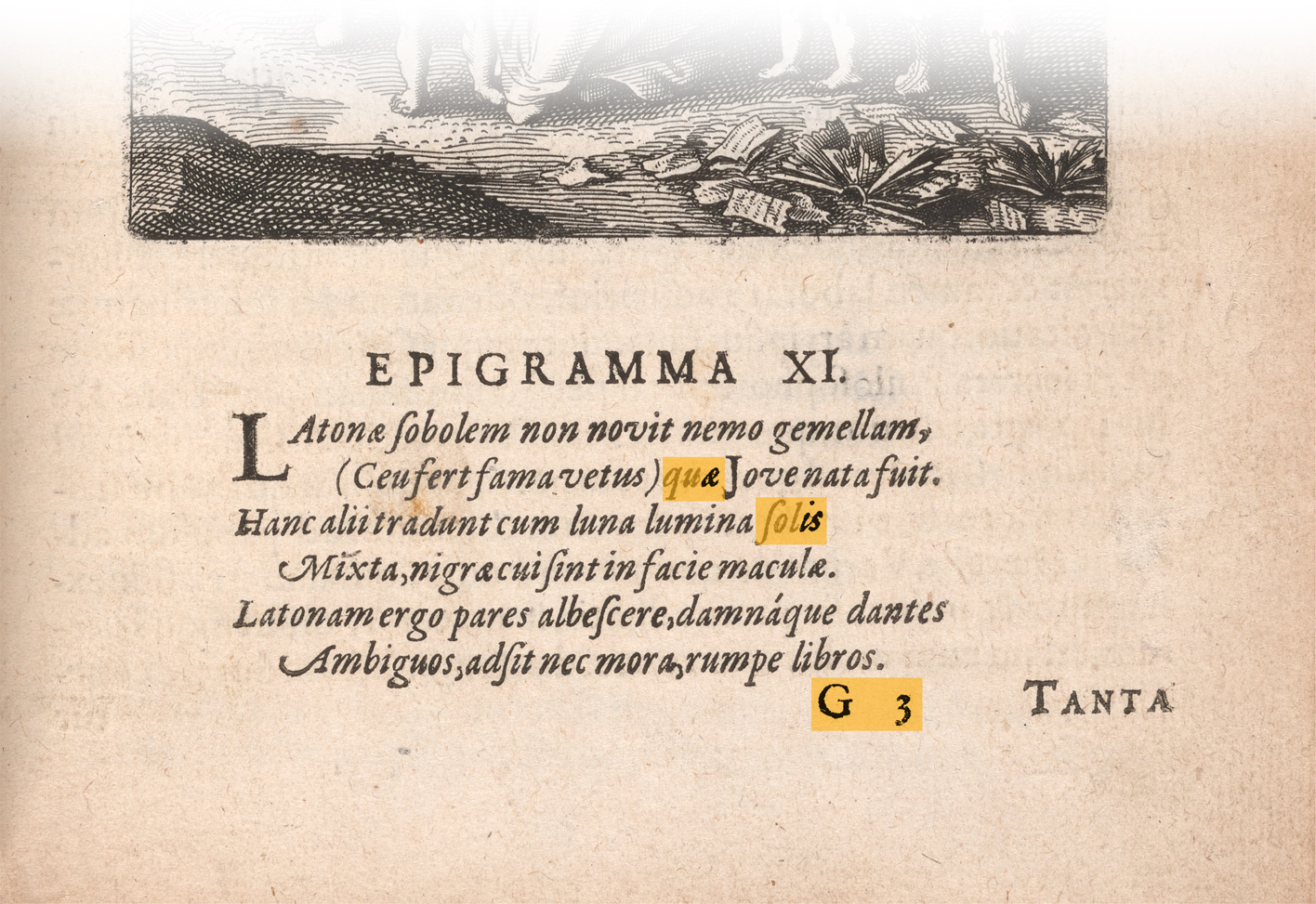
The text was typeset by hand, about one metal letter per second. (The example above contains some examples of two letters cast on one body — the “æ” ligature in “quæ,” for example, and the “is” in “solis.” These helped to create a more calligraphic effect.) The music was set in the same way, note by note, each with its own section of staves. Figure 2 shows the gaps and discontinuities between the notes, characteristic of typeset music.

Typesetting music was a specialized skill, particularly prone to typos, and it is possible that Galler subcontracted this part of the work to someone else. Even so, mistakes remain in the finished book.
Figure 3 shows a printing press very like the one that would have been used by Galler. Although the quire (the sheet) was the structural unit of the book, Galler could only machine one side of the sheet at a time. The group of pages on the press at any one time was called a forme, and for the pressman this was the basic production unit. In the case of Maier’s quarto publication it consisted of four pages, and as you will see if you make a quire by folding a sheet of paper once in each direction, these pages were not continuous. Thus, the printer had to have his wits about him when arranging his pages to print.
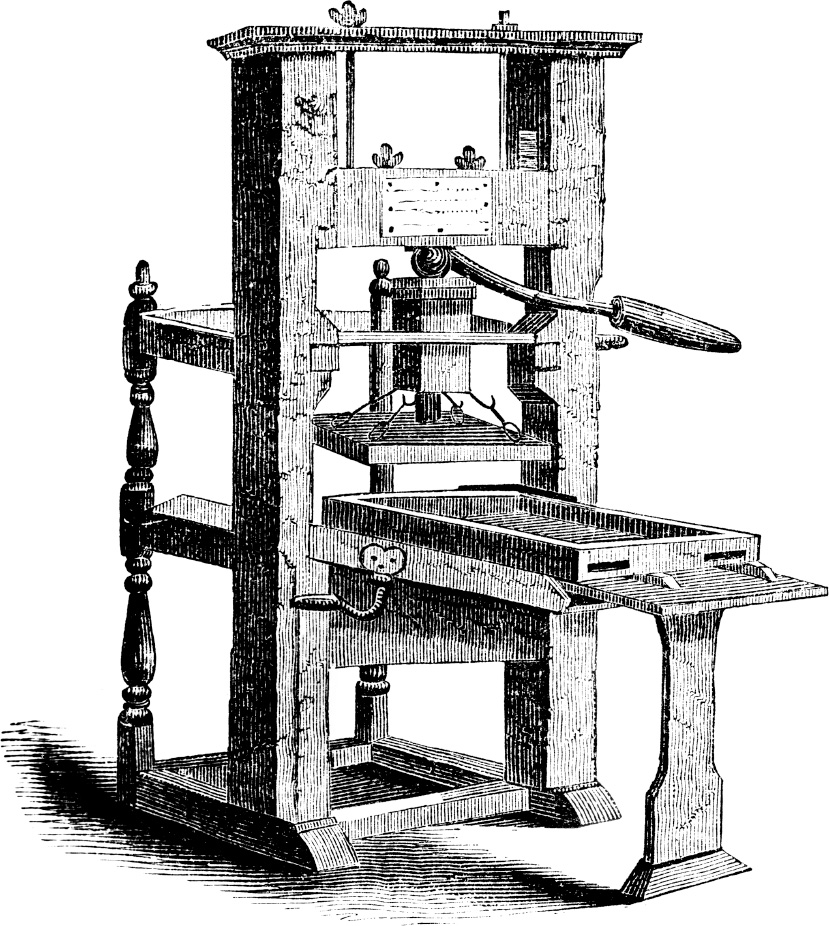
Figure 3
During the printing of a forme, a proofreader was usually at work. If he found errors, the press could be stopped and the type corrected; this process could repeat. The sheets already printed were not thrown away — the paper was half the cost of the book — so each sheet of the edition might have several correction states. When the sheets were collated to produce finished copies of the whole book, there was no compelling reason for early states of all the sheets to end up in the same copies. For this reason it is meaningless to speak of early or late copies of a hand-printed book; there are only early or late states of the individual formes. Figure 4 shows the Atalanta fugiens forme from quire O, containing pages 105, 108, 109, and 112, as it came off of Galler’s press.
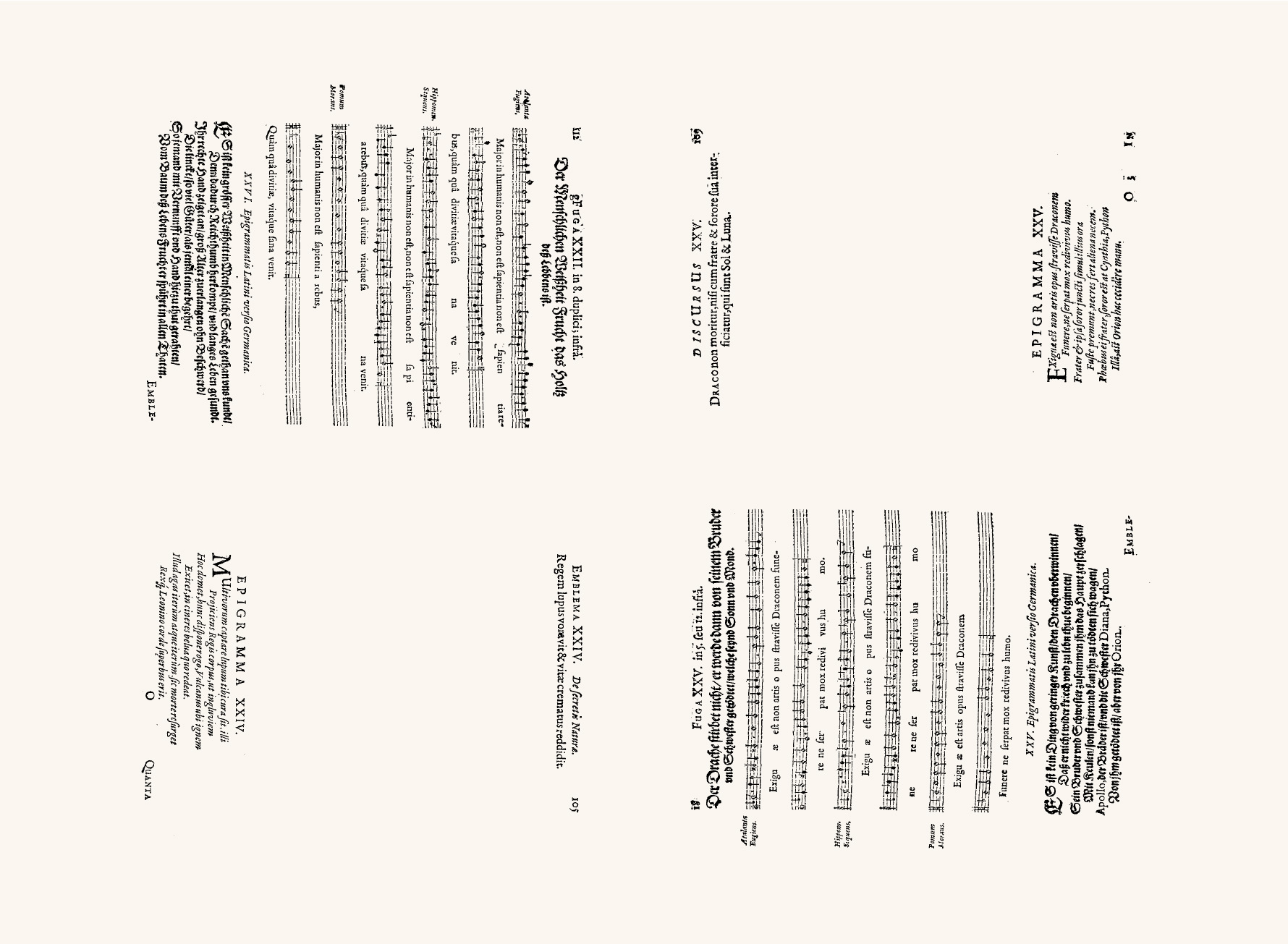
We can immediately see that something is wrong here: the illustrations are missing. That is because they were created by a different process requiring a second production run on a different kind of press. The process, called intaglio, started with a polished copper plate. The plate was coated with a thin, acid-resistant layer, then the artist’s design was transferred to it; alternatively, the platemaker could work freehand from his model. (For Atalanta fugiens the artist was Matthäus Merian, although the plate was probably worked by one of his craftsman associates.) The platemaker used a sharp point to cut the design through the acid resist to the bare metal, then immersed the plate in an acid bath. The acid etched the design into shallow grooves; the process could be repeated to darken certain areas, or the platemaker could engrave stronger lines directly into the plate. Finally, the plate was cleared of the resist and printing could begin. Figure 5 shows an etched copperplate by Rembrandt, executed sixteen years after Atalanta fugiens.
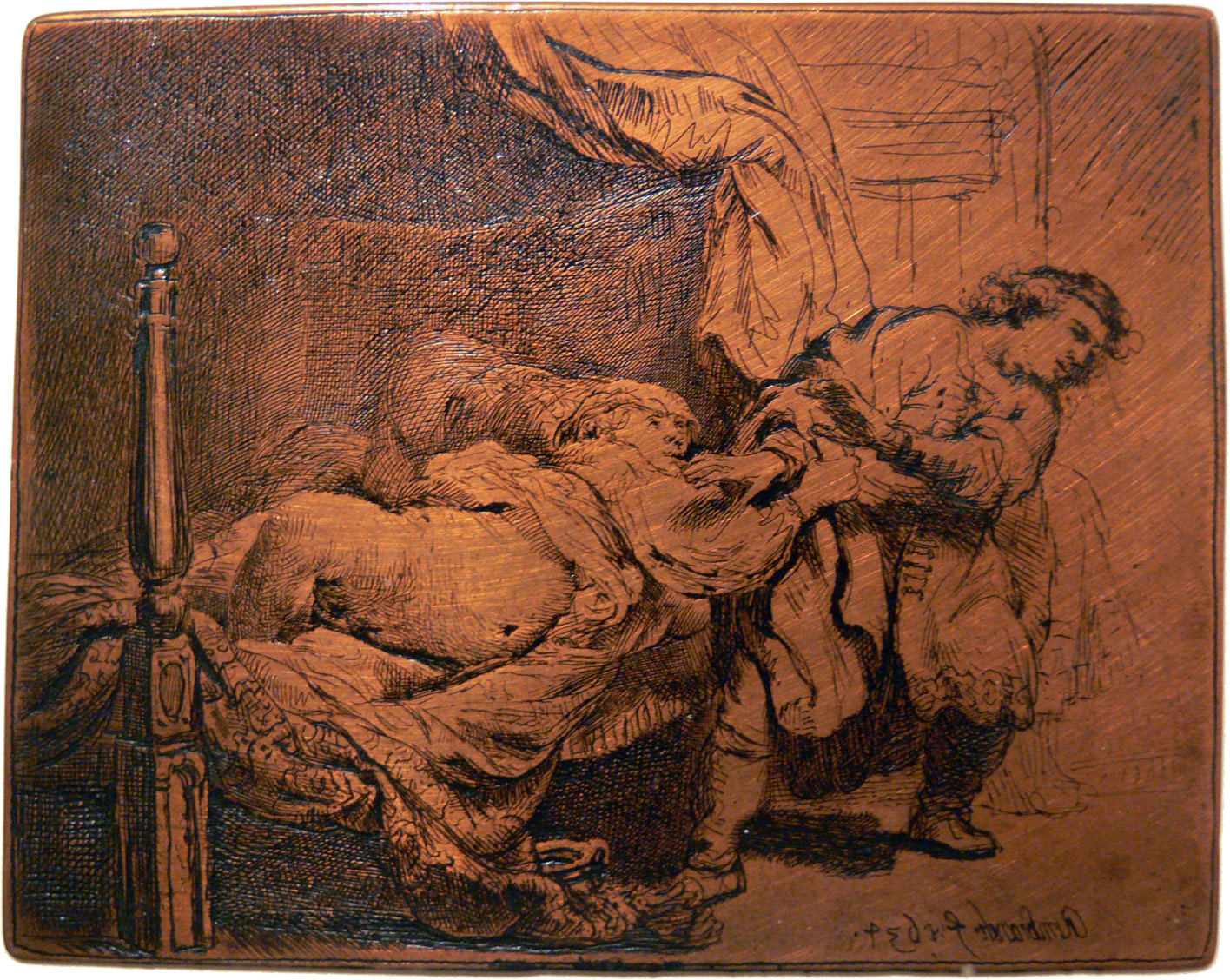
Letterpress text is printed by inking the raised letter surfaces and pressing them into the paper. Intaglio is different: the printer coats the entire plate with ink, then polishes off the flat surface, leaving ink only in the crevices. For each plate in Atalanta fugiens, this process alone took several minutes. The plates were then set onto the blank spaces of the letterpress sheets and run through a rolling press, a steamroller-like apparatus that produced immense pressure along a moving line to push the paper into the grooves of the plate where it picked up the ink. Using foot pressure helped to turn the rollers, and the impression of the metal plate’s edge is usually visible just outside the image on the printed page (fig. 6).
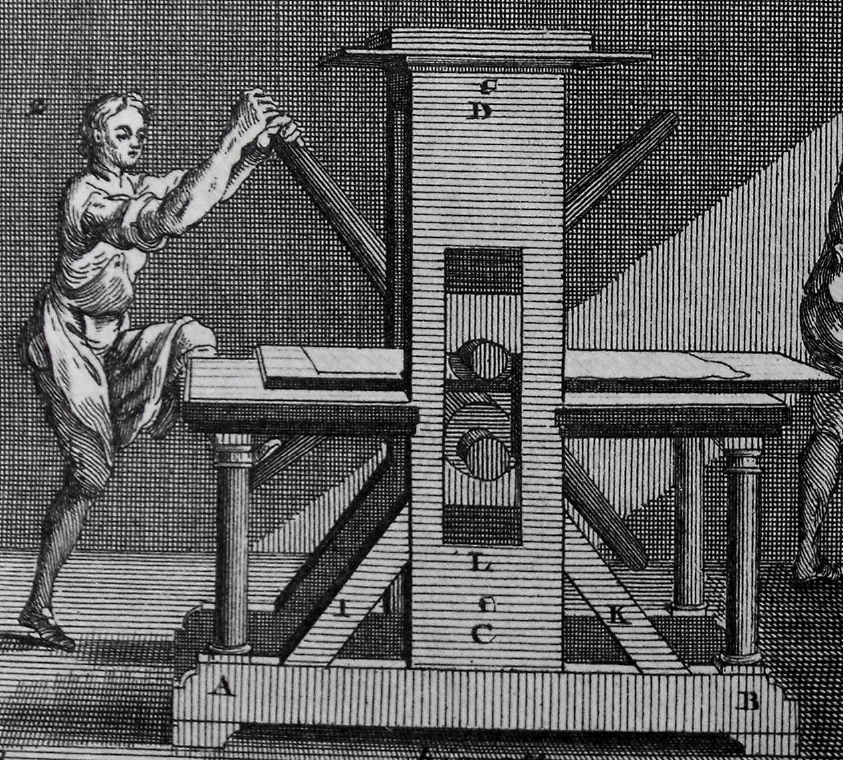
Figure 6
For Atalanta fugiens, the words and music were printed in Galler’s shop, and then the sheets were transferred to a rolling press for completion (fig. 7). The example shown here went through the rolling press with two copperplates whose placement on the sheet was slightly crooked. Every copy of this sheet would be just a bit different in this regard, and if the plate printer’s mind was wandering, the illustrations might come out upside down or interchanged. Aligning and registering the hollow rectangular copperplate border on the title page outside the already-printed letterpress text must have been particularly ticklish.

Copies of the book are known with and without the portrait of a resolute Michael Maier on page 11. We don’t know the reason it appears in some copies and not others; perhaps the finished plate arrived too late to be printed in the earliest ones sold. We wouldn’t necessarily expect it to occur on the sheets with the latest correction state of the text, but this is a matter for further investigation.
Atalanta fugiens was cleverly designed so that the difficult parts — the music and the illustrations — fall on only one of the two formes of each sheet. The backing formes contain the straightforward texts of the Discursi, which by comparison were child’s play to produce. From Galler’s viewpoint it must have seemed almost like working on two separate books of very different levels of complexity. All told, every copy of Atalanta fugiens represents eighty-one runs through a press — eighty-two for copies with the portrait. Multiply that number by the unknown number of copies in the edition, perhaps on the order of one thousand, and factor in a few other publications that Galler was probably working on simultaneously, and you get a feeling for the complexity of an early modern printing operation.


